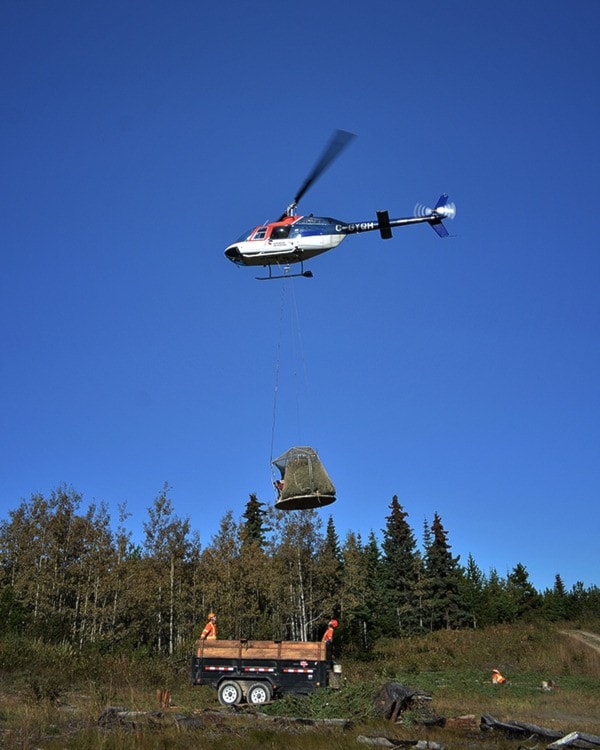An old-growth stand of forest approximately 5000 hectares in size may contain the seeds of our future forests, literally. The stand, on the northwest shores of Francois Lake - known as the Tercer area - is the largest stand of predominately Douglas fir trees in the Lakes timber supply area (TSA).
With the seemingly inevitable march of global warming and the steady shift in bio-geoclimactic zones within B.C.’s forest (see Lakes District News, May 29, 2012), the ubiquitous pine tree may be a future loser.
It’s a bit of a genetic gamble when it comes to planning for the tomorrow’s forests, but that’s exactly what staff in the provincial Ministry of Forests, Lands and Natural Resource Operations (MFLNRO) are asked to do.
“Four per cent of the current forest landbase in the Lakes TSA is Douglas fir, with 75 per cent of that tied up in small parks” said Carolyn Stevens, senior resource specialist with the Burns Lake Nadina office of the MFLNRO. “Douglas fir is a winner in climate change. Spruce will do okay, but pine is going to be a loser.”
Pine is sensitive to infestations, temperature changes and changes in soil moisture. Interior Douglas fir is a robust tree more suited to the drier, warmer climate on the rise throughout B.C.’s northern interior regions.
Stevens manages the Forests for Tomorrow program in the Lakes TSA. Forests for Tomorrow is a provincial program started in 2005 in response to major wildfires and the mountain pine beetle epidemic.
Currently, across the entire land base, less than one per cent of new tree stock planted are Douglas fir, with the rest a mix of pine and spruce. Stevens aims for 5 to twenty per cent Douglas fir under Forests for Tomorrow.
Although pine might have the deck stacked against it from a climate-change point of view, it does have one major point in its favour: a pine sapling grows fast and is ready for a second harvest up to 20 years earlier than a Douglas fir sapling.
“Douglas fir produces a better quality wood, but it can take 80 or 90 years before a fir matures into a harvestable size,” Stevens said. “Pine can be ready in 60 or 80 years.”
A quicker maturation process means that pine plantations are off forest licensee’s liability tables earlier than waiting for a slower species to grow. Forest licensees are required to care for their tree plantations until they are ‘free to grow’, or capable of continued growth without further care from the licensee who harvested the original crop of trees.
For every fir tree planted, approximately three seeds need to be collected. The process is labour intensive, and requires a skilled helicopter pilot to manoeuvre not only close to the forest canopy line, but often below it.
A large, gas-powered combination thrasher and collector is carried on a short line below a helicopter as the pilot lowers it down onto tree tops to thrash tree tops and recover seed cones which are shaken loose and fall into the thrasher’s netting.
It’s a dangerous gig for a pilot - and for those relying on the pilot’s skill - and Stevens insists on one particular pilot, captain Tom Brooks, with Canadian Helicopters out of Smithers, B.C.
Brooks makes his rounds of the stand, honing in on fir trees that haven’t blown their cones and spread their seed already. Once his collection netting is full, he makes his way back to the seed collection site where the ground crew sorts the cones from the small branches that they’re attached to.
The cones are bagged and carefully racked for transport to Smithers, where they’re housed in climate-controlled environment. Once they’ve dried out there, they’ll be sent to a seed storage facility in Surrey.
“Douglas fir seeds are a hard collect,” Stevens said. “They’re susceptible to fungus, and mildew. Even dust can trigger a fungal infection that can destroy a whole seed lot.”
Given how sensitive Douglas fir seeds are to moisture, there’s only a small window when they can be collected.
The seeds need to be ready for harvest, but a heavy storm could ruin the collection effort.
In less than three weeks, Stevens and her crew of seed collectors will have harvested seeds in Burns Lake, Fraser Lake and Isle Pierre, closer to Prince George.
They are hoping to collect over 70,000 seeds from this Tercer stand alone.
“These are very healthy cones,” Stevens said. “Typically we need three seeds to produce one successful sapling, but these seeds might produce two to one.”
There isn’t a lot of Douglas fir this far north west in the province. The Lakes TSA contains the furthest north west stands of interior Douglas fir in the province. With the Tercer stand the largest and healthiest stand in the area, it is a special place and holds a unique role in the Lakes District future forest.
“We already know what doesn’t work,” Stevens added, referring to past mono-culture planting. “There’s a limited amount of Douglas fir left,” she said. “We’re collecting seeds to diversify the Lakes TSA.”
